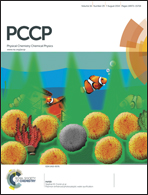Analysis of parahydrogen polarized spin system in low magnetic fields†
Abstract
Nuclear magnetic resonance (NMR) spectra of spin systems polarized either thermally or by parahydrogen exhibit strikingly different field dependencies. Thermally polarized spin systems show the well-known roof effect, observed when reducing magnetic field strengths which precludes the independent determination of chemical shift differences and J-coupling constants at low-fields. Quantum mechanical analysis of the NMR spectra with respect to polarization method, pulsed state preparation, and transition probabilities reveals that spectra of parahydrogen polarized systems feature an “inverse roof effect” in the regime where the chemical shift difference δν is smaller than J. This inverse roof effect allows for the extraction of both J-coupling and chemical shift information down to very low fields. Based on a two-spin system, the observed non-linear magnetic field dependence of the splitting of spectral lines is predicted. We develop a general solution for the steady state density matrix of a parahydrogen polarized three-spin system including a heteronucleus which allows explaining experimentally observed 1H spectra. The analysis of three-spin density matrix illustrates two pathways for an efficient polarization transfer from parahydrogen to 13C nuclei. Examination of the experimental data facilitates the extraction of all relevant NMR parameters using single-scan, high-resolution 1H and 13C NMR spectroscopy at low fields at a fraction of the cost associated with cryogenically cooled high-field NMR spectrometers.


 Please wait while we load your content...
Please wait while we load your content...